maintenance TOYOTA COROLLA 2020 Warranties & Maintenance Guides (in English)
[x] Cancel search | Manufacturer: TOYOTA, Model Year: 2020, Model line: COROLLA, Model: TOYOTA COROLLA 2020Pages: 260, PDF Size: 8.54 MB
Page 114 of 260
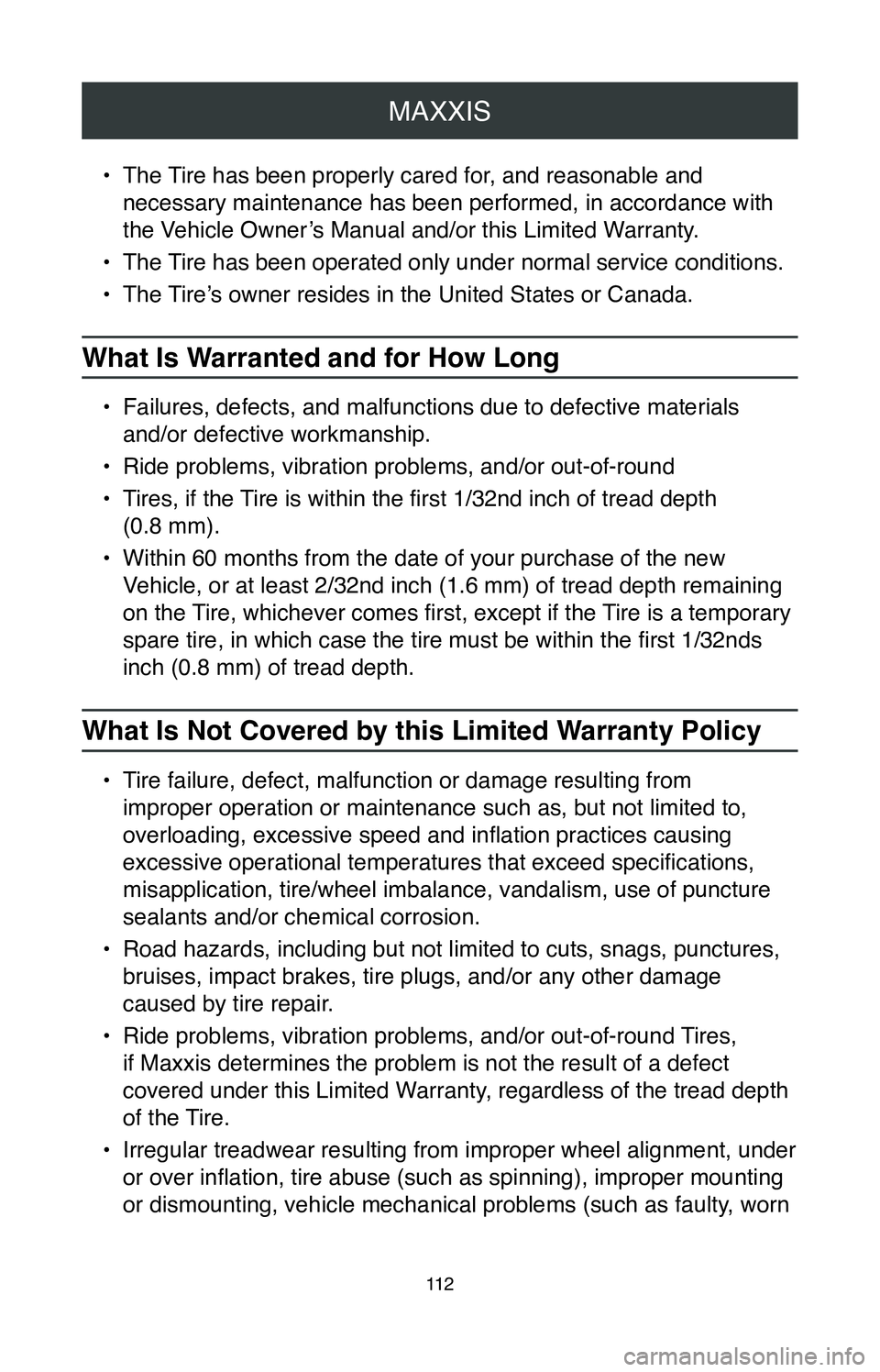
MAXXIS
11 2
• The Tire has been properly cared for, and reasonable and
necessary maintenance has been performed, in accordance with
the Vehicle Owner’s Manual and/or this Limited Warranty.
•
The Tire has been operated only under normal service conditions.
•
The Tire’s owner resides in the United States or Canada.
What Is Warranted and for How Long
• Failures, defects, and malfunctions due to defective materials
and/or defective workmanship.
•
Ride problems, vibration problems, and/or out-of-round
•
Tires, if the Tire is within the first 1/32nd inch of tread depth
(0.8 mm).
•
Within 60 months from the date of your purchase of the new
Vehicle, or at least 2/32nd inch (1.6 mm) of tread depth remaining
on the Tire, whichever comes first, except if the Tire is a temporary
spare tire, in which case the tire must be within the first 1/32nds
inch (0.8 mm) of tread depth.
What Is Not Covered by this Limited Warranty Policy
• Tire failure, defect, malfunction or damage resulting from
improper operation or maintenance such as, but not limited to,
overloading, excessive speed and inflation practices causing
excessive operational temperatures that exceed specifications,
misapplication, tire/wheel imbalance, vandalism, use of puncture
sealants and/or chemical corrosion.
•
Road hazards, including but not limited to cuts, snags, punctures,
bruises, impact brakes, tire plugs, and/or any other damage
caused by tire repair.
•
Ride problems, vibration problems, and/or out-of-round Tires,
if Maxxis determines the problem is not the result of a defect
covered under this Limited Warranty, regardless of the tread depth
of the Tire.
•
Irregular treadwear resulting from improper wheel alignment, under
or over inflation, tire abuse (such as spinning), improper mounting
or dismounting, vehicle mechanical problems (such as faulty, worn
Page 117 of 260
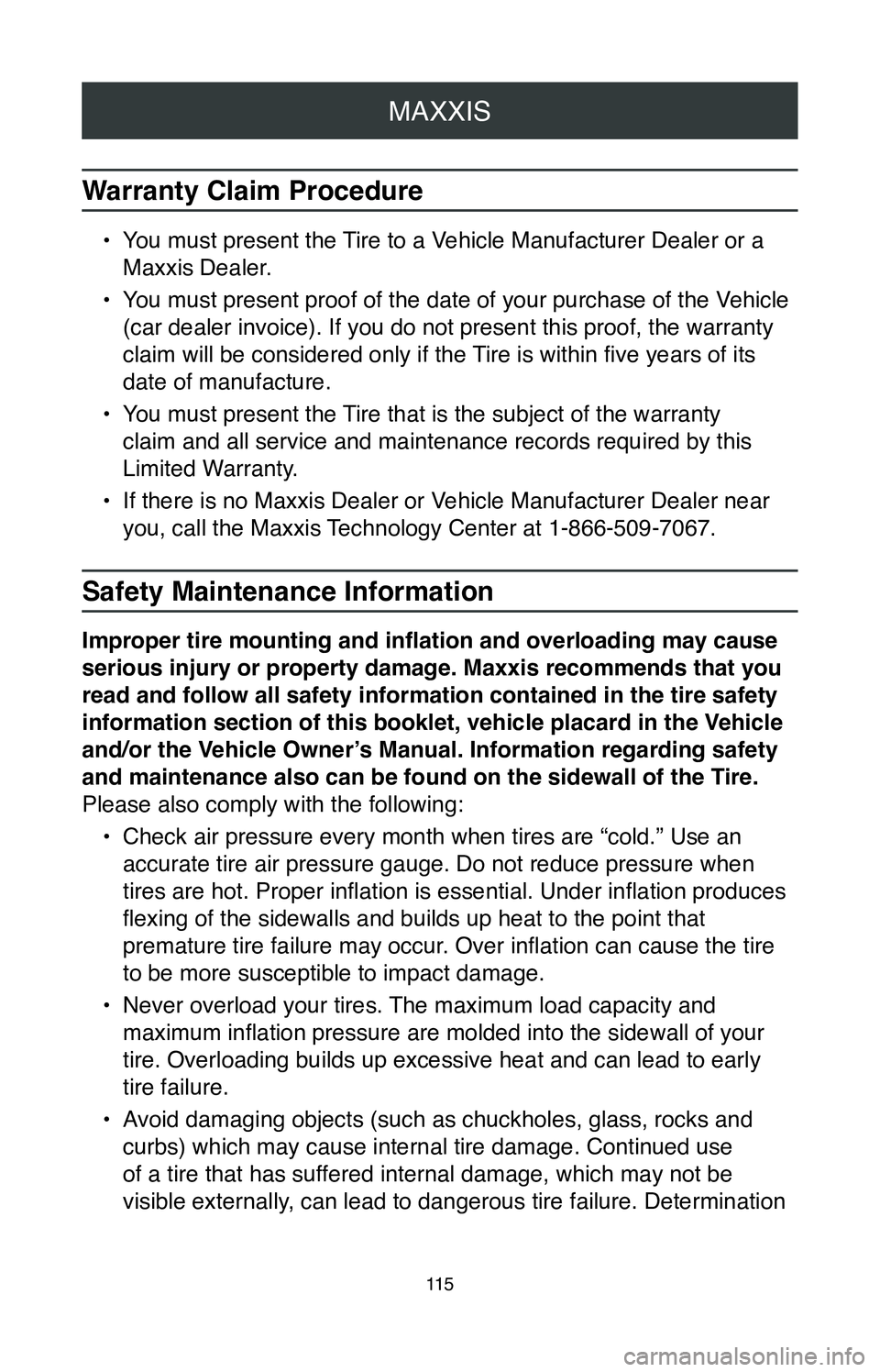
MAXXIS
11 5
Warranty Claim Procedure
• You must present the Tire to a Vehicle Manufacturer Dealer or a
Maxxis Dealer.
•
You must present proof of the date of your purchase of the Vehicle
(car dealer invoice). If you do not present this proof, the warranty
claim will be considered only if the Tire is within five years of its
date of manufacture.
•
You must present the Tire that is the subject of the warranty
claim and all service and maintenance records required by this
Limited Warranty.
•
If there is no Maxxis Dealer or Vehicle Manufacturer Dealer near
you, call the Maxxis Technology Center at 1-866-509-7067.
Safety Maintenance Information
Improper tire mounting and inflation and overloading may cause
serious injury or property damage. Maxxis recommends that you
read and follow all safety information contained in the tire safety
information section of this booklet, vehicle placard in the Vehicle
and/or the Vehicle Owner’s Manual. Information regarding safety
and maintenance also can be found on the sidewall of the Tire.
Please also comply with the following: •
Check air pressure every month when tires are “cold.” Use an
accurate tire air pressure gauge. Do not reduce pressure when
tires are hot. Proper inflation is essential. Under inflation produces
flexing of the sidewalls and builds up heat to the point that
premature tire failure may occur. Over inflation can cause the tire
to be more susceptible to impact damage.
•
Never overload your tires. The maximum load capacity and
maximum inflation pressure are molded into the sidewall of your
tire. Overloading builds up excessive heat and can lead to early
tire failure.
•
Avoid damaging objects (such as chuckholes, glass, rocks and
curbs) which may cause internal tire damage. Continued use
of a tire that has suffered internal damage, which may not be
visible externally, can lead to dangerous tire failure. Determination
Page 119 of 260
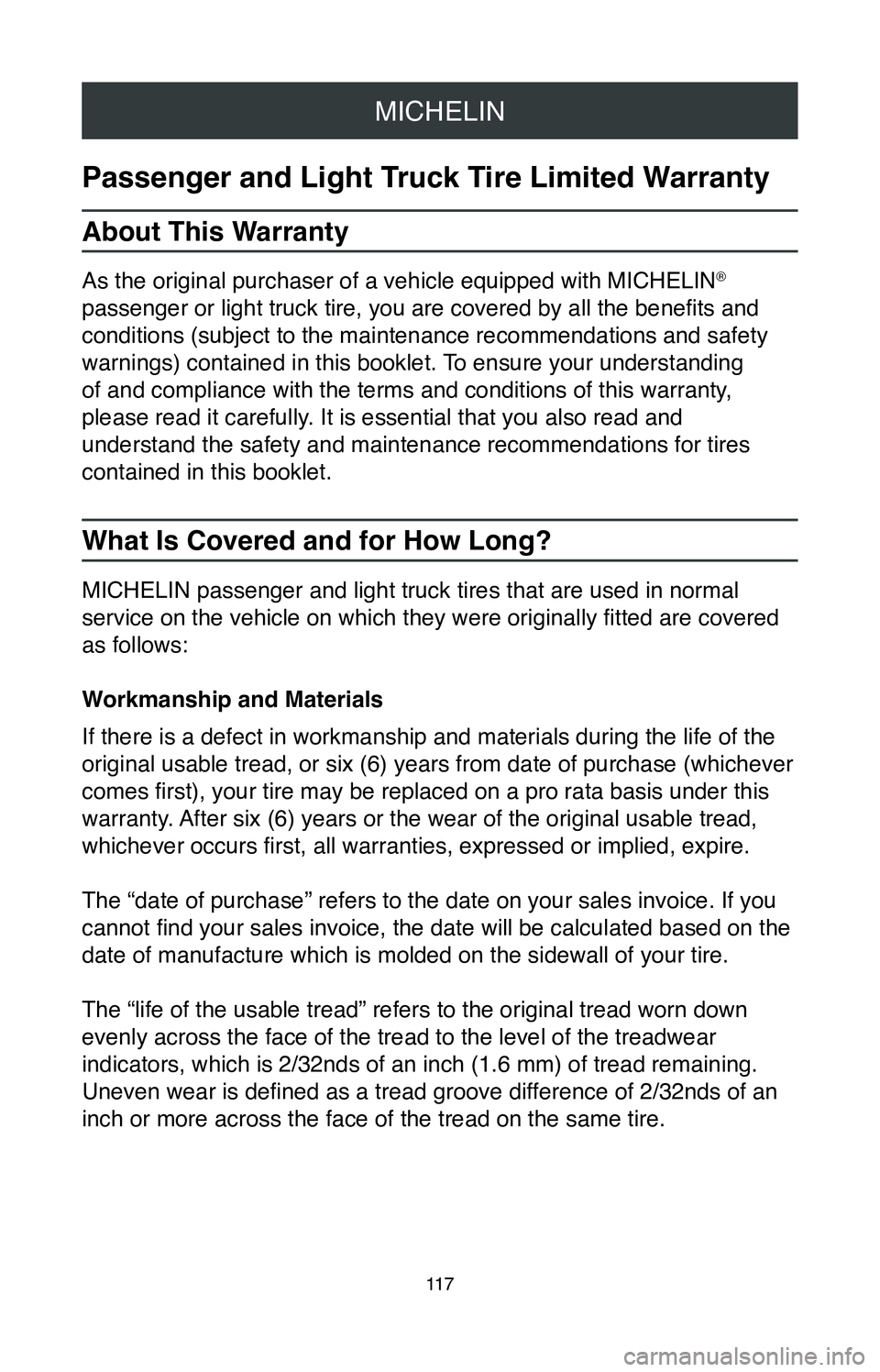
MICHELIN
11 7
Passenger and Light Truck Tire Limited Warranty
About This Warranty
As the original purchaser of a vehicle equipped with MICHELIN®
passenger or light truck tire, you are covered by all the benefits and
conditions (subject to the maintenance recommendations and safety
warnings) contained in this booklet. To ensure your understanding
of and compliance with the terms and conditions of this warranty,
please read it carefully. It is essential that you also read and
understand the safety and maintenance recommendations for tires
contained in this booklet.
What Is Covered and for How Long?
MICHELIN passenger and light truck tires that are used in normal
service on the vehicle on which they were originally fitted are covered
as follows:
Workmanship and Materials
If there is a defect in workmanship and materials during the life of the\
original usable tread, or six (6) years from date of purchase (whichever
comes first), your tire may be replaced on a pro rata basis under this
warranty. After six (6) years or the wear of the original usable tread,
whichever occurs first, all warranties, expressed or implied, expire.
The “date of purchase” refers to the date on your sales invoice. I\
f you
cannot find your sales invoice, the date will be calculated based on the
date of manufacture which is molded on the sidewall of your tire.
The “life of the usable tread” refers to the original tread worn d\
own
evenly across the face of the tread to the level of the treadwear
indicators, which is 2/32nds of an inch (1.6 mm) of tread remaining.
Uneven wear is defined as a tread groove difference of 2/32nds of an
inch or more across the face of the tread on the same tire.
Page 120 of 260
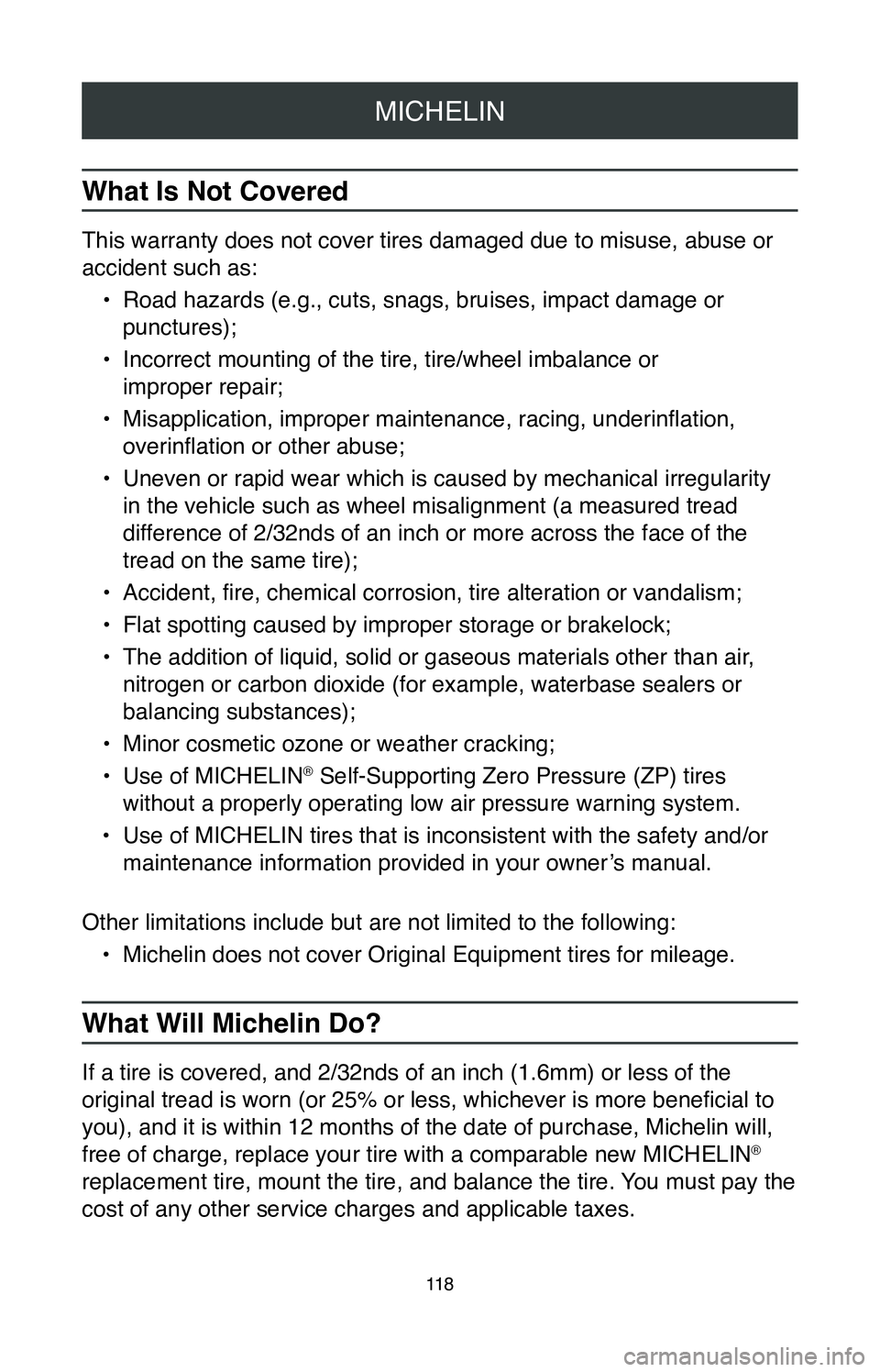
MICHELIN
11 8
What Is Not Covered
This warranty does not cover tires damaged due to misuse, abuse or
accident such as:•
Road hazards (e.g., cuts, snags, bruises, impact damage or
punctures);
•
Incorrect mounting of the tire, tire/wheel imbalance or
improper repair;
•
Misapplication, improper maintenance, racing, underinflation,
overinflation or other abuse;
•
Uneven or rapid wear which is caused by mechanical irregularity
in the vehicle such as wheel misalignment (a measured tread
difference of 2/32nds of an inch or more across the face of the
tread on the same tire);
•
Accident, fire, chemical corrosion, tire alteration or vandalism;
•
Flat spotting caused by improper storage or brakelock;
•
The addition of liquid, solid or gaseous materials other than air,
nitrogen or carbon dioxide (for example, waterbase sealers or
balancing substances);
•
Minor cosmetic ozone or weather cracking;
•
Use of MICHELIN® Self-Supporting Zero Pressure (ZP) tires
without a properly operating low air pressure warning system.
•
Use of MICHELIN tires that is inconsistent with the safety and/or
maintenance information provided in your owner’s manual.
Other limitations include but are not limited to the following: •
Michelin does not cover Original Equipment tires for mileage.
What Will Michelin Do?
If a tire is covered, and 2/32nds of an inch (1.6mm) or less of the
original tread is worn (or 25% or less, whichever is more beneficial to
you), and it is within 12 months of the date of purchase, Michelin will\
,
free of charge, replace your tire with a comparable new MICHELIN
®
replacement tire, mount the tire, and balance the tire. You must pay the
cost of any other service charges and applicable taxes.
Page 121 of 260
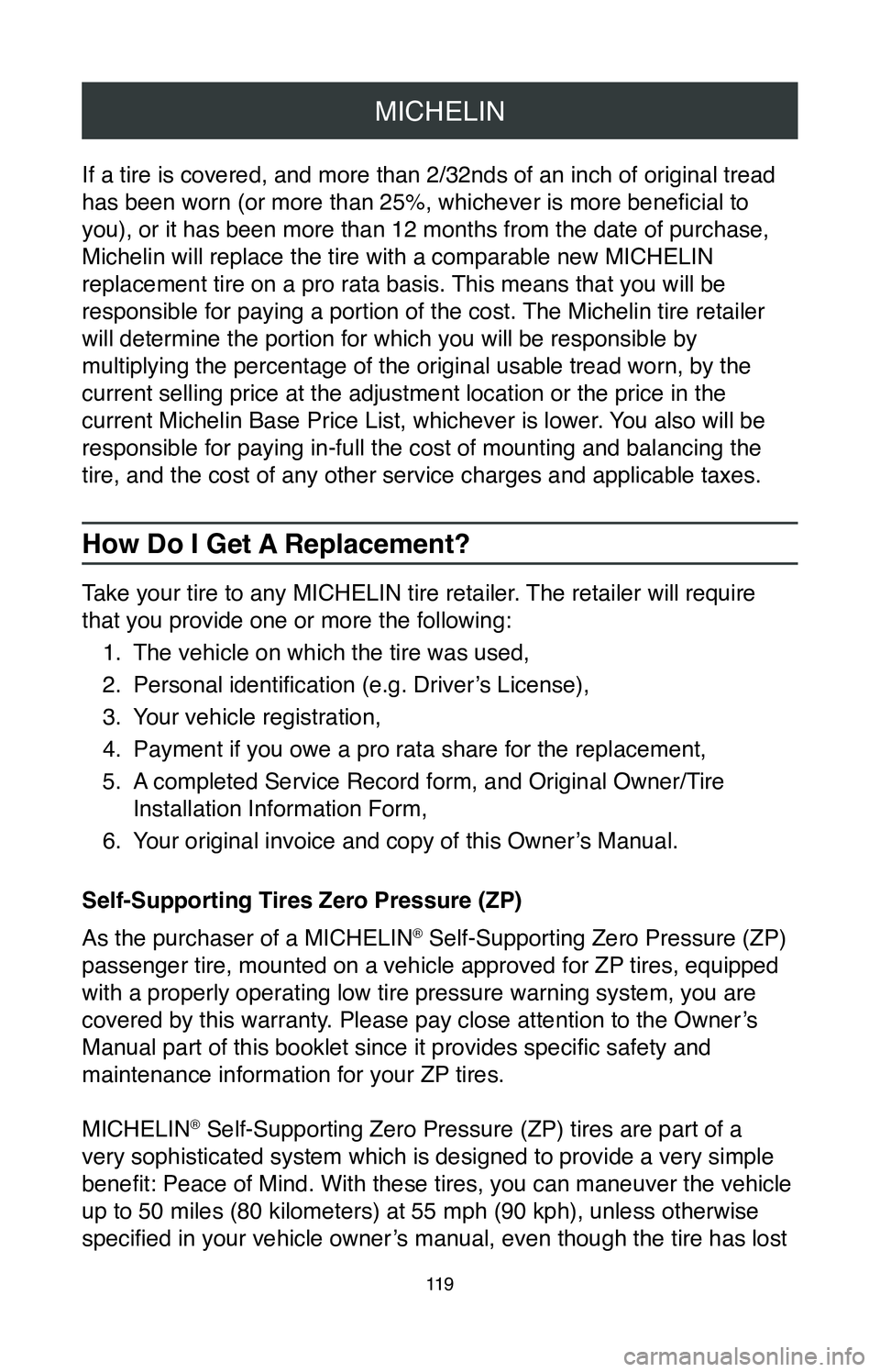
MICHELIN
11 9
If a tire is covered, and more than 2/32nds of an inch of original tread\
has been worn (or more than 25%, whichever is more beneficial to
you), or it has been more than 12 months from the date of purchase,
Michelin will replace the tire with a comparable new MICHELIN
replacement tire on a pro rata basis. This means that you will be
responsible for paying a portion of the cost. The Michelin tire retailer
will determine the portion for which you will be responsible by
multiplying the percentage of the original usable tread worn, by the
current selling price at the adjustment location or the price in the
current Michelin Base Price List, whichever is lower. You also will be
responsible for paying in-full the cost of mounting and balancing the
tire, and the cost of any other service charges and applicable taxes.
How Do I Get A Replacement?
Take your tire to any MICHELIN tire retailer. The retailer will require
that you provide one or more the following:1.
The vehicle on which the tire was used,
2.
Personal identification (e.g. Driver’s License),
3.
Your vehicle registration,
4.
Payment if you owe a pro rata share for the replacement,
5.
A completed Service Record form, and Original Owner/Tire
Installation Information Form,
6.
Your original invoice and copy of this Owner’s Manual.
Self-Supporting Tires Zero Pressure (ZP)
As the purchaser of a MICHELIN
® Self-Supporting Zero Pressure (ZP)
passenger tire, mounted on a vehicle approved for ZP tires, equipped
with a properly operating low tire pressure warning system, you are
covered by this warranty. Please pay close attention to the Owner’s
Manual part of this booklet since it provides specific safety and
maintenance information for your ZP tires.
MICHELIN
® Self-Supporting Zero Pressure (ZP) tires are part of a
very sophisticated system which is designed to provide a very simple
benefit: Peace of Mind. With these tires, you can maneuver the vehicle
up to 50 miles (80 kilometers) at 55 mph (90 kph), unless otherwise
specified in your vehicle owner’s manual, even though the tire has lost
Page 124 of 260
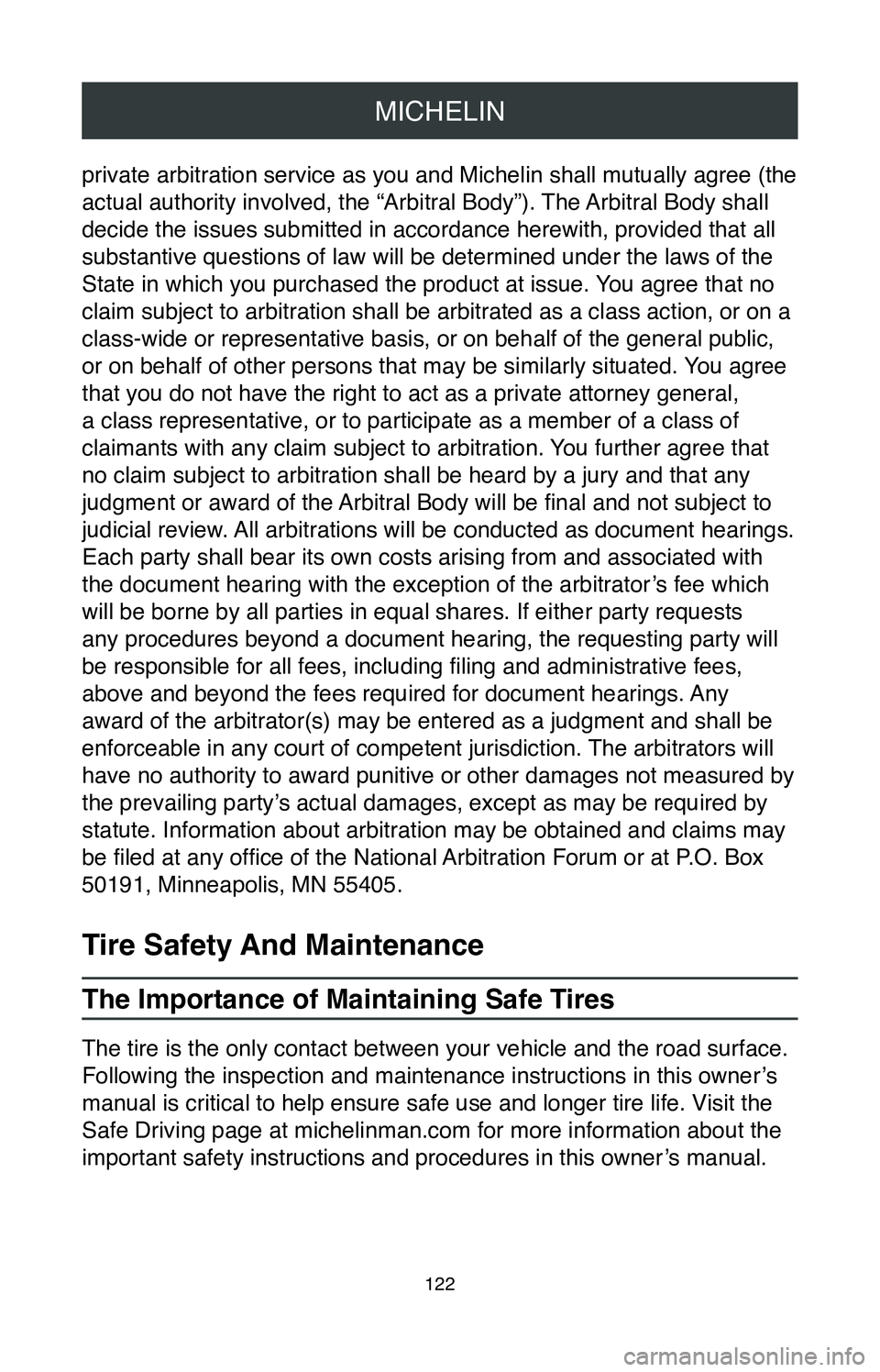
MICHELIN
122
private arbitration service as you and Michelin shall mutually agree (the
actual authority involved, the “Arbitral Body”). The Arbitral Body shall
decide the issues submitted in accordance herewith, provided that all
substantive questions of law will be determined under the laws of the
State in which you purchased the product at issue. You agree that no
claim subject to arbitration shall be arbitrated as a class action, or on a
class-wide or representative basis, or on behalf of the general public,
or on behalf of other persons that may be similarly situated. You agree
that you do not have the right to act as a private attorney general,
a class representative, or to participate as a member of a class of
claimants with any claim subject to arbitration. You further agree that
no claim subject to arbitration shall be heard by a jury and that any
judgment or award of the Arbitral Body will be final and not subject to
judicial review. All arbitrations will be conducted as document hearings.
Each party shall bear its own costs arising from and associated with
the document hearing with the exception of the arbitrator’s fee which
will be borne by all parties in equal shares. If either party requests
any procedures beyond a document hearing, the requesting party will
be responsible for all fees, including filing and administrative fees,
above and beyond the fees required for document hearings. Any
award of the arbitrator(s) may be entered as a judgment and shall be
enforceable in any court of competent jurisdiction. The arbitrators will
have no authority to award punitive or other damages not measured by
the prevailing party’s actual damages, except as may be required by
statute. Information about arbitration may be obtained and claims may
be filed at any office of the National Arbitration Forum or at P.O. Box
50191, Minneapolis, MN 55405.
Tire Safety And Maintenance
The Importance of Maintaining Safe Tires
The tire is the only contact between your vehicle and the road surface. \
Following the inspection and maintenance instructions in this owner’s
manual is critical to help ensure safe use and longer tire life. Visit the
Safe Driving page at michelinman.com for more information about the
important safety instructions and procedures in this owner’s manual.
Page 125 of 260
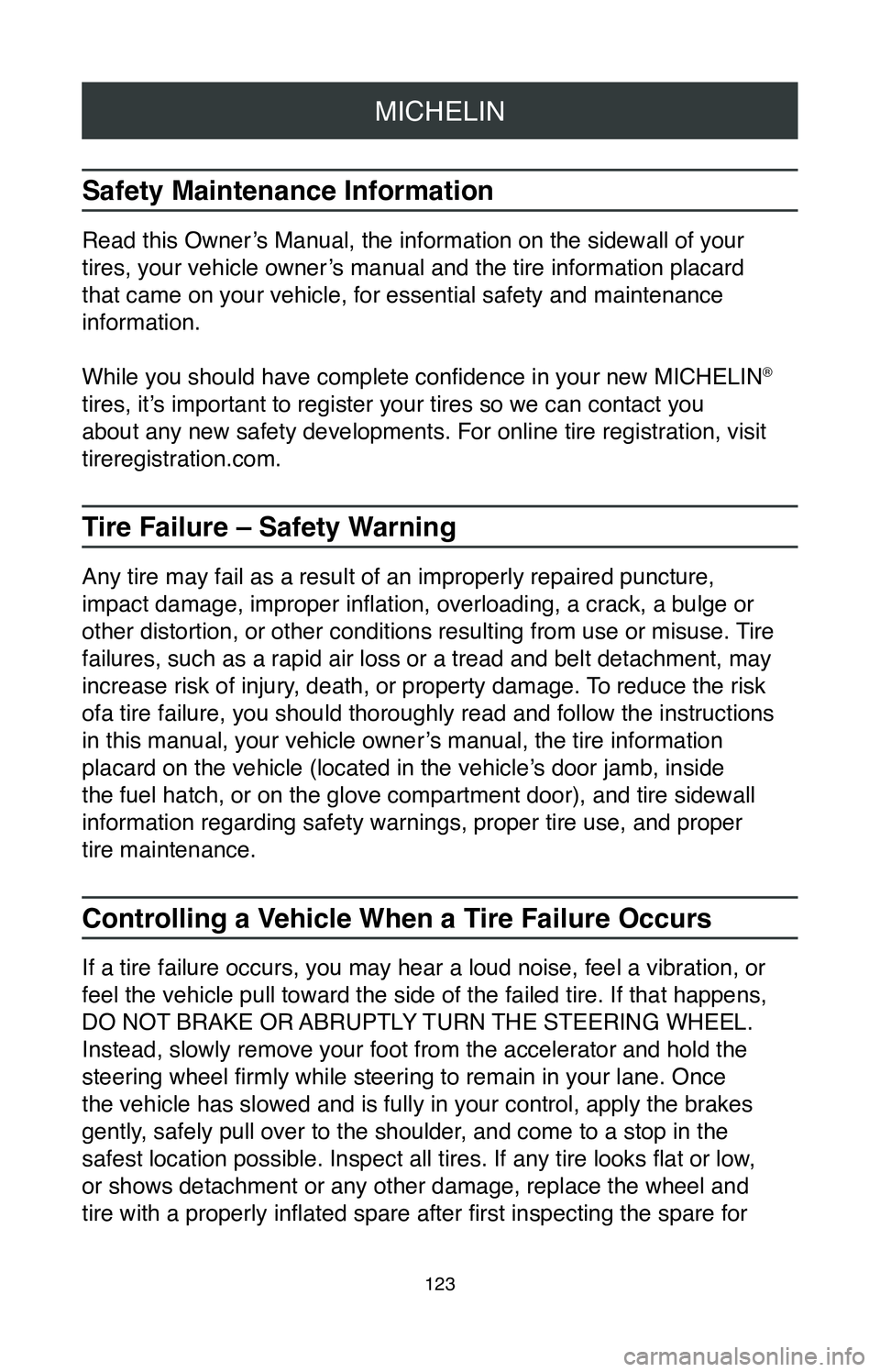
MICHELIN
123
Safety Maintenance Information
Read this Owner’s Manual, the information on the sidewall of your
tires, your vehicle owner’s manual and the tire information placard
that came on your vehicle, for essential safety and maintenance
information.
While you should have complete confidence in your new MICHELIN
®
tires, it’s important to register your tires so we can contact you
about any new safety developments. For online tire registration, visit
tireregistration.com.
Tire Failure – Safety Warning
Any tire may fail as a result of an improperly repaired puncture,
impact damage, improper inflation, overloading, a crack, a bulge or
other distortion, or other conditions resulting from use or misuse. Tire
failures, such as a rapid air loss or a tread and belt detachment, may
increase risk of injury, death, or property damage. To reduce the risk
ofa tire failure, you should thoroughly read and follow the instructions\
in this manual, your vehicle owner’s manual, the tire information
placard on the vehicle (located in the vehicle’s door jamb, inside
the fuel hatch, or on the glove compartment door), and tire sidewall
information regarding safety warnings, proper tire use, and proper
tire maintenance.
Controlling a Vehicle When a Tire Failure Occurs
If a tire failure occurs, you may hear a loud noise, feel a vibration, o\
r
feel the vehicle pull toward the side of the failed tire. If that happen\
s,
DO NOT BRAKE OR ABRUPTLY TURN THE STEERING WHEEL.
Instead, slowly remove your foot from the accelerator and hold the
steering wheel firmly while steering to remain in your lane. Once
the vehicle has slowed and is fully in your control, apply the brakes
gently, safely pull over to the shoulder, and come to a stop in the
safest location possible. Inspect all tires. If any tire looks flat or low ,
or shows detachment or any other damage, replace the wheel and
tire with a properly inflated spare after first inspecting the spare for
Page 144 of 260
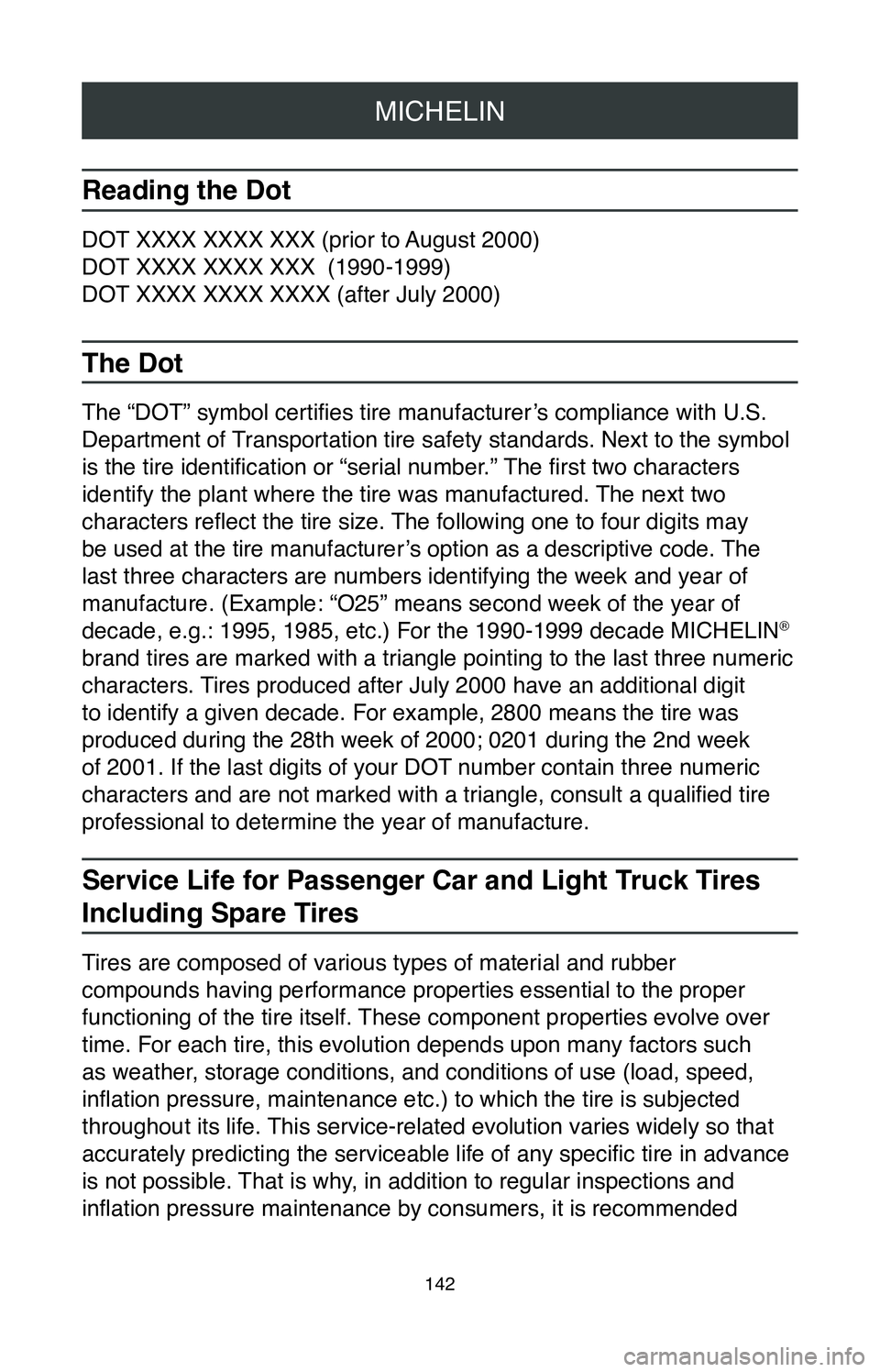
MICHELIN
142
Reading the Dot
DOT XXXX XXXX XXX (prior to August 2000)
DOT XXXX XXXX XXX
(1990-1999)
DOT XXXX XXXX XXXX (after July 2000)
The Dot
The “DOT” symbol certifies tire manufacturer’s compliance with U.S.
Department of Transportation tire safety standards. Next to the symbol
is the tire identification or “serial number.” The first two characters
identify the plant where the tire was manufactured. The next two
characters reflect the tire size. The following one to four digits may
be used at the tire manufacturer’s option as a descriptive code. The
last three characters are numbers identifying the week and year of
manufacture. (Example: “O25” means second week of the year of
decade, e.g.: 1995, 1985, etc.) For the 1990-1999 decade MICHELIN
®
brand tires are marked with a triangle pointing to the last three numeri\
c
characters. Tires produced after July 2000 have an additional digit
to identify a given decade. For example, 2800 means the tire was
produced during the 28th week of 2000; 0201 during the 2nd week
of 2001. If the last digits of your DOT number contain three numeric
characters and are not marked with a triangle, consult a qualified tire
professional to determine the year of manufacture.
Service Life for Passenger Car and Light Truck Tires
Including Spare Tires
Tires are composed of various types of material and rubber
compounds having performance properties essential to the proper
functioning of the tire itself. These component properties evolve over
time. For each tire, this evolution depends upon many factors such
as weather, storage conditions, and conditions of use (load, speed,
inflation pressure, maintenance etc.) to which the tire is subjected
throughout its life. This service-related evolution varies widely so that
accurately predicting the serviceable life of any specific tire in advance
is not possible. That is why, in addition to regular inspections and
inflation pressure maintenance by consumers, it is recommended
Page 148 of 260
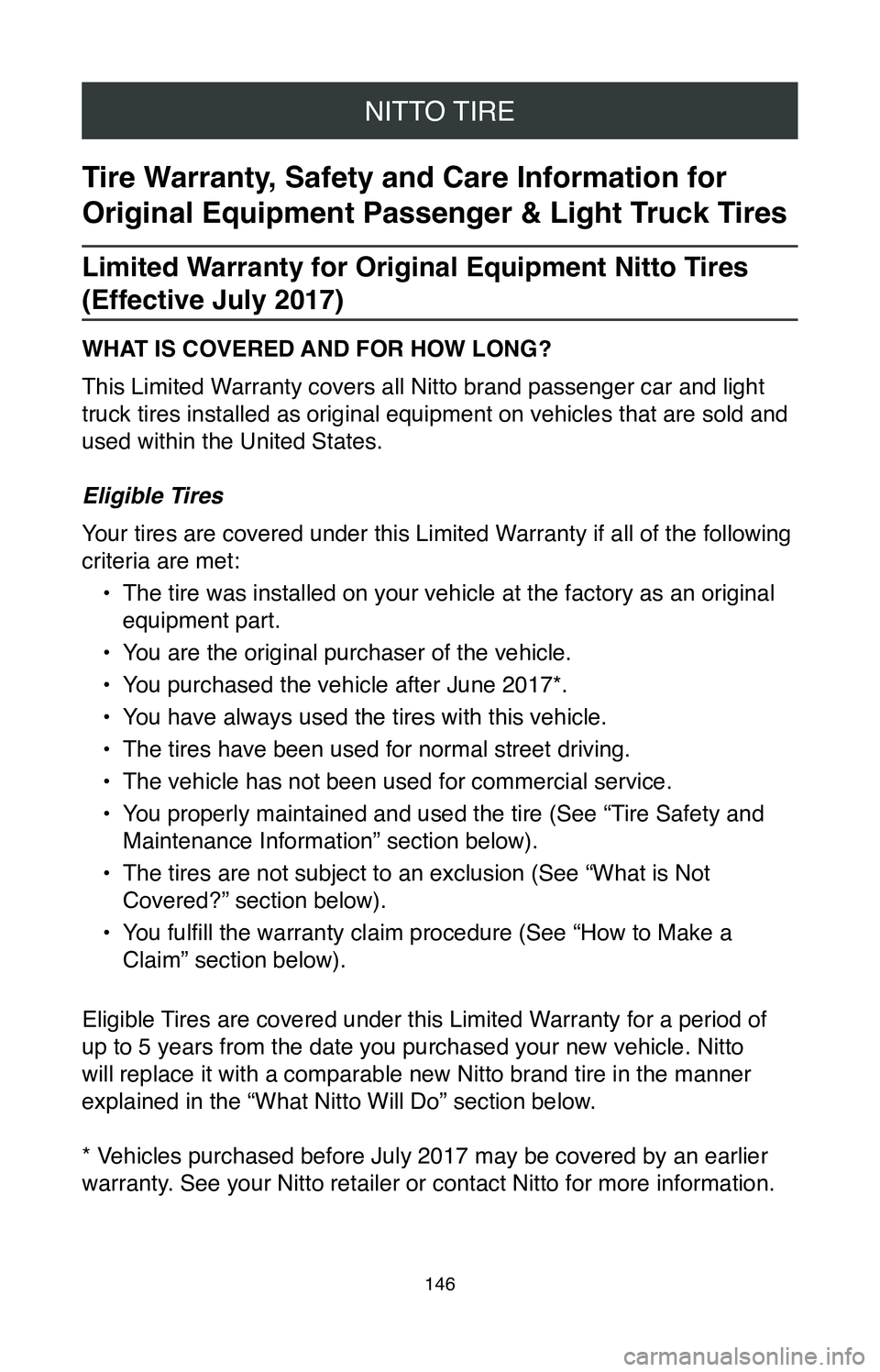
NITTO TIRE
146
Tire Warranty, Safety and Care Information for
Original Equipment Passenger & Light Truck Tires
Limited Warranty for Original Equipment Nitto Tires
(Effective July 2017)
WHAT IS COVERED AND FOR HOW LONG?
This Limited Warranty covers all Nitto brand passenger car and light
truck tires installed as original equipment on vehicles that are sold an\
d
used within the United States.
Eligible Tires
Your tires are covered under this Limited Warranty if all of the following
criteria are met:•
The tire was installed on your vehicle at the factory as an original
equipment part.
•
You are the original purchaser of the vehicle.
•
You purchased the vehicle after June 2017*.
•
You have always used the tires with this vehicle.
•
The tires have been used for normal street driving.
•
The vehicle has not been used for commercial service.
•
You properly maintained and used the tire (See “Tire Safety and
Maintenance Information” section below).
•
The tires are not subject to an exclusion (See “What is Not
Covered?” section below).
•
You fulfill the warranty claim procedure (See “How to Make a
Claim” section below).
Eligible Tires are covered under this Limited Warranty for a period of
up to 5 years from the date you purchased your new vehicle. Nitto
will replace it with a comparable new Nitto brand tire in the manner
explained in the “What Nitto Will Do” section below.
* Vehicles purchased before July 2017 may be covered by an earlier
warranty. See your Nitto retailer or contact Nitto for more information.
Page 149 of 260
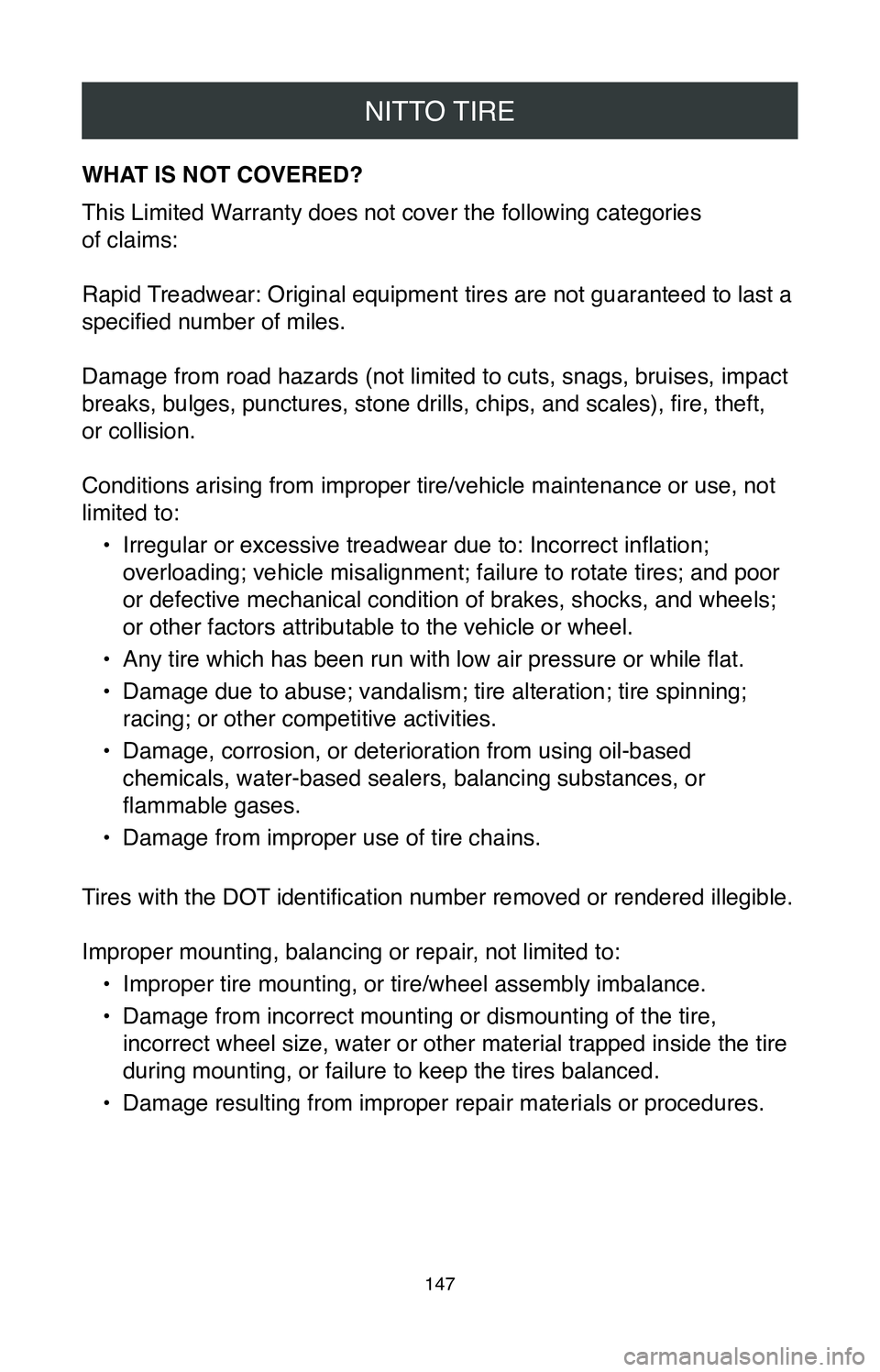
NITTO TIRE
147
WHAT IS NOT COVERED?
This Limited Warranty does not cover the following categories
of claims:
Rapid Treadwear: Original equipment tires are not guaranteed to last a
specified number of miles.
Damage from road hazards (not limited to cuts, snags, bruises, impact
breaks, bulges, punctures, stone drills, chips, and scales), fire, theft,
or collision.
Conditions arising from improper tire/vehicle maintenance or use, not
limited to:
•
Irregular or excessive treadwear due to: Incorrect inflation;
overloading; vehicle misalignment; failure to rotate tires; and poor
or defective mechanical condition of brakes, shocks, and wheels;
or other factors attributable to the vehicle or wheel.
•
Any tire which has been run with low air pressure or while flat.
•
Damage due to abuse; vandalism; tire alteration; tire spinning;
racing; or other competitive activities.
•
Damage, corrosion, or deterioration from using oil-based
chemicals, water-based sealers, balancing substances, or
flammable gases.
•
Damage from improper use of tire chains.
Tires with the DOT identification number removed or rendered illegible.
Improper mounting, balancing or repair, not limited to: •
Improper tire mounting, or tire/wheel assembly imbalance.
•
Damage from incorrect mounting or dismounting of the tire,
incorrect wheel size, water or other material trapped inside the tire
during mounting, or failure to keep the tires balanced.
•
Damage resulting from improper repair materials or procedures.